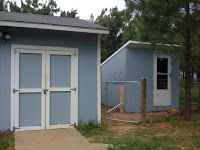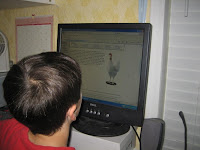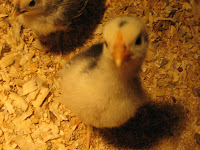Building a Chicken House

Are you kidding me--a house for chickens?
We were inspired by the altered economy to attempt some self-sufficiency goals that had long been on the back burner. If we were going to start with a larger garden and some chickens for eggs this year and meat next year, then we felt that as good stewards of these animals, we needed to give them a home.
Only a few decent floor plans were available on the internet, so Dennis and I designed our own chicken house using the best ideas of all that we read.
Basing the size of the house on the number and type of chickens we planned to raise, we also allowed a little extra room for future growth or to add some Cornish meat birds next year. We selected a place away from the house but close to our tool shed.
Because lumber and plywood are generally in 8' lengths, we wanted little waste. We designed the dwelling to measure just under 8'X8' with a 2' slanted roof and constructed it with 6 nest boxes which we can access from outside the building. Several ventilation windows, a slide-down chicken door, a storm door to allow light but keep out rain and drafts were included in the plans.
Here is how we constructed our chicken house (can easily accommodate 22 Bantam chickens)
1) First, we created a “foundation” by laying and leveling 9 cinder blocks below the surface of the ground (one in each of the four corners and 1 in each of the 5 centers). We then constructed the footer out of 5 treated 4” X 4” X 8’ beams.
2) Using 5 treated 2” X 4” ‘s, we then nailed the floor joist across the footers.
3) Two additional 2 x 4's were cut to size and nailed between the joists for added floor support.
4) To finish the floor,we used two 4' X 8' sheets of treated plywood and nailed it to the prepared platform.
5) We built the frame of the first wall to include two 3' nesting boxes that would allow access to the nests from the outside. Forming the wall with a 2’ slant for rain drainage, the wall measured 8' in the front to 6' in the back. The nest wall took twelve 2 X 4's to construct.The back wall was then framed and measured 8'W X 6'H. We framed out 2 ventilation windows on this back wall (not shown in this photo) and used seven 2X4's to construct.
6) The 3rd wall, of course, also had a 2’ slant that exactly mirrored the nest wall's outside measurements. We framed out a ventilation window on this wall as well and stapled heavy gauge mesh to all vent windows before hanging the plywood.
7) The final wall was measured to accommodate a 32” storm door. It is 8’ wide X 8’ high. After the four walls were up, we notched the studs out and inserted cross beams for added structural support. We also framed 2’ X 2’ ventilation windows on the back wall and another small ventilation window on the wall opposite the nest boxes.
8) After the walls were up and the nest access doors,ventilation windows, storm door, and chicken doors were framed out, we constructed the rafters for the roof, cut and hung the plywood and shingled the roof.
9) We planned the spacing between the shed and the chicken house to include a walk-in enclosed cage to keep young birds. The nest box wall has a small chicken door leading to this space. A second door option was built on the opposite wall to lead out to the 200' run; we’ll give them access to the “big boy” yard when they’re a little older and can stand up to small predators that might climb the fence (like our cats, Lucy & Ethel!)
10) The chicken dwelling is nestled in the small pine grove whose branches can, to some degree, conceal the birds from hawks and flying prey. A 4' high fence will hopefully deter other predators (like our and the neighbors' dogs) from entering the pen. If needed, we can consider adding a small line of electric wire 4" above ground level.
We didn't use treated plywood for the outside walls because we chose to prime and paint it instead. I know, I'm picky...I want my out-dwellings to match the shed and the house.
If the rain finally lets up, it will be "moving day" for our mid-sized chicks. As of today, they are still in the shed (in a refrigerator box); but the "natives" are getting restless, and it's time for them to fly the cardboard coop. Sadly, we'll do so knowing these egg laying feathered friends plan to decorate the interior with their droppings. Our work has only just begun!
(Maybe one will lay a golden egg!)






























